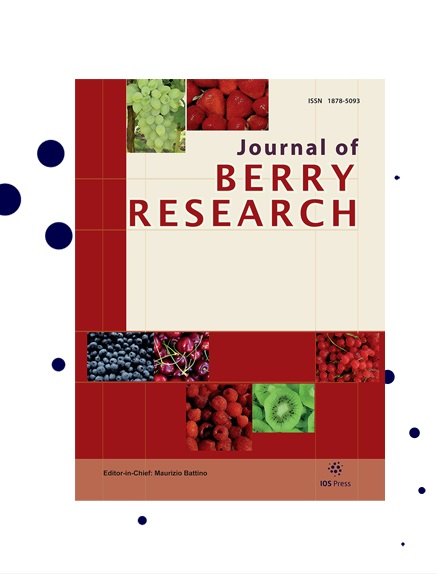Optimisation of blueberry (Vaccinium corymbosum L.) press residue extraction using a combination of pectolytic enzyme and ultrasound treatments
IF 1.4
4区 农林科学
Q3 PLANT SCIENCES
引用次数: 1
Abstract
Blueberries are one of the most popular and widely consumed berries, they are usually consumed fresh, dried or processed into juice. During the production of juices large quantities of berry press residues are generated, which are an industrial by-product and they accumulate as food waste. Optimal management of this industrial fruit by-product could help in utilising berry press residues with the purpose to valorise and add economic value. Blueberry press residues consist of skins and seeds which hold valuable compounds with antioxidant activity –polyphenolics. To facilitate the objective of bioactive compound release, the cell walls must rupture. Pectolytic enzymes could be used to degrade the structural polysaccharides of the berry skin cell wall, thus releasing the contents of the cells into the extraction medium. The physical characteristics of berry skins allows the use of pectolytic enzymes for the disruption of cells; however, the effects of enzymatic hydrolysis could be further improved using ultrasound. In this study the combined effects of enzyme and ultrasonic treatments were evaluated and optimised using the Response Surface Methodology approach in order to increase the release of polyphenolic compounds (especially anthocyanins). The optimised method was further tested to evaluate the application potential of enzyme and ultrasound treatment to prepare blueberry or lingonberry juice with increased antioxidant activity and more vibrant colour. The obtained results provide an optional method of berry press residue valorisation to produce higher quality juice or extract bioactive compounds from this type of food-waste.应用果胶酶和超声波联合处理优化蓝莓(Vaccinium corymbolsum L.)压榨残渣的提取
蓝莓是最受欢迎和消费最广泛的浆果之一,它们通常被新鲜、干燥或加工成果汁食用。在果汁生产过程中,会产生大量的浆果压榨残留物,这是一种工业副产品,它们会作为食物垃圾积累起来。对这种工业水果副产品的最佳管理有助于利用浆果压榨残留物,从而提高价格并增加经济价值。蓝莓压榨残留物由果皮和种子组成,其中含有具有抗氧化活性的有价值的化合物——多酚类物质。为了促进生物活性化合物的释放,细胞壁必须破裂。果胶酶可用于降解浆果皮细胞壁的结构多糖,从而将细胞中的内容物释放到提取介质中。浆果皮的物理特性允许使用果胶酶破坏细胞;然而,使用超声波可以进一步改善酶水解的效果。在本研究中,使用响应面方法评估和优化了酶和超声波处理的联合效果,以增加多酚化合物(尤其是花青素)的释放。进一步测试了优化的方法,以评估酶和超声处理在制备抗氧化活性增强、颜色更鲜艳的蓝莓或黑莓汁方面的应用潜力。所获得的结果提供了一种可选的浆果压榨残渣增值方法,以生产更高质量的果汁或从这种类型的食物垃圾中提取生物活性化合物。
本文章由计算机程序翻译,如有差异,请以英文原文为准。
求助全文
约1分钟内获得全文
求助全文
来源期刊

Journal of Berry Research
Biochemistry, Genetics and Molecular Biology-Biochemistry
CiteScore
3.50
自引率
11.80%
发文量
21
期刊介绍:
The main objective of the Journal of Berry Research is to improve the knowledge about quality and production of berries to benefit health of the consumers and maintain profitable production using sustainable systems. The objective will be achieved by focusing on four main areas of research and development:
From genetics to variety evaluation
Nursery production systems and plant quality control
Plant physiology, biochemistry and molecular biology, as well as cultural management
Health for the consumer: components and factors affecting berries'' nutritional value
Specifically, the journal will cover berries (strawberry, raspberry, blackberry, blueberry, cranberry currants, etc.), as well as grapes and small soft fruit in general (e.g., kiwi fruit). It will publish research results covering all areas of plant breeding, including plant genetics, genomics, functional genomics, proteomics and metabolomics, plant physiology, plant pathology and plant development, as well as results dealing with the chemistry and biochemistry of bioactive compounds contained in such fruits and their possible role in human health. Contributions detailing possible pharmacological, medical or therapeutic use or dietary significance will be welcomed in addition to studies regarding biosafety issues of genetically modified plants.
 求助内容:
求助内容: 应助结果提醒方式:
应助结果提醒方式:


